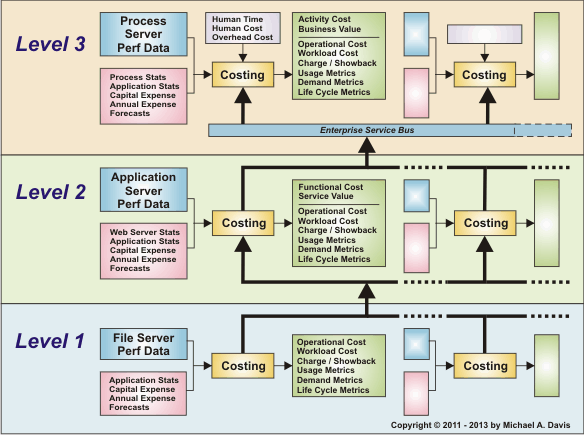Understand IT Cost
The topic of IT cost is not a
popular one and the
business usually just
accepts the high cost of IT.
What they want is
information on how the IT
cost applies to the business
processes. For Business
Management to truly
understand the value of IT,
they must first understand
the cost of IT. The extent
that IT costs are linked to
the business indicates
where the business is in
the Costing Maturity Model.
Different Views
Cost insight requires
different views of the same
information, and for IT,
this includes linking
consumer costs with
technical metrics. Differing
views allow consumers to
forecast in their native
terms and then translates
the business information
into the technical measures
required for equipment
provisioning.
Links IT to Business
The Cost Maturity Model is
based on the Software
Oriented Architecture
framework and is used to
link the IT costs to the
consumers and business
processes. It allows for the
inclusion of business
centric data that is used to
form business metrics that
are based on business
measures.
All RG Solutions® processing is based on a Resource Catalog. This catalog is used to define assets,
the costs associated with the assets, the processing constraints for some of the assets, and the
relationship of assets to other assets. A Resource can be thought of as a standalone entity that can
be shared with other Resources to form a hybrid structure. This framework mirrors the structure
present within an IT shop and supports a Software Defined Datacenter.
File Servers
RG Solutions® uses logical systems in the Resource Catalog that map to physical systems within the
IT operations. Its processing combines incoming technical information from the actual system,
resource cost, and business values to form the technical and cost metrics for the corresponding
system.
The isolated processing from each physical system forms the first level of the maturity model.
While these systems can be self contained (does not need any external information), they are
generally used in conjunction with other system processing. In a tiered architecture, these systems
are typically the ones that maintain the corporate information.
Web Services
The second level of the model is concerned with the delivery of Web Services to and for the business.
The delivery of a single service to the user is generally made up of a series of internal services that
come from different files servers or other web servers. For true cost linking and understanding, the
metrics for each internal service must be identified and linked to the final service delivered to the
consumer.
RG Solutions® uses this framework for linking and combining of shared resource consumption.
The shared resources are generally used in an irregular manner and have to be dynamically
allocated as determined by data flows. RG Solutions® does this by linking the system workloads with
the shared workloads from the systems that provide them.
Business Processes
Metric requirements for Levels 1 and 2 of the model have been around for a long time, but the Level
3 requirements were introduced with the SOA framework. RG Solutions® provides an Activity Catalog
that is used to link the business processes with the underlying systems and services.
Unlike the processing in the first two levels, the cost of processing in this level includes a large
amount of human resources that are typically not directly related to the IT operations. These costs
and data sources are accommodated and combined in the processing to provide a complete view of
the business process metrics and costs.


